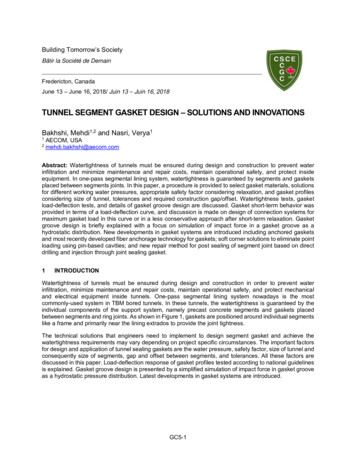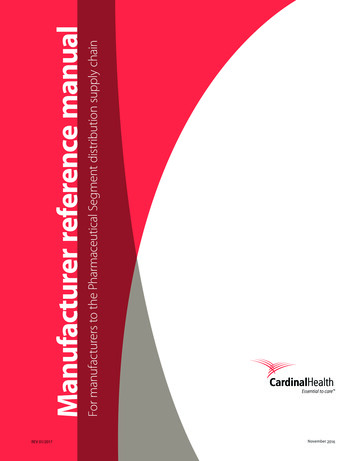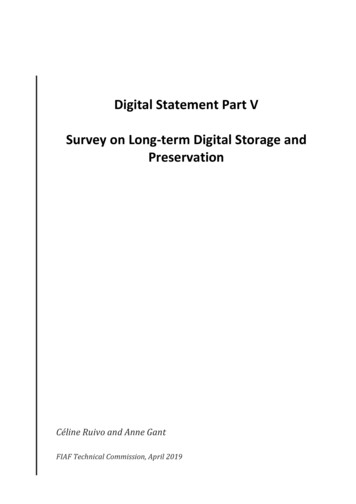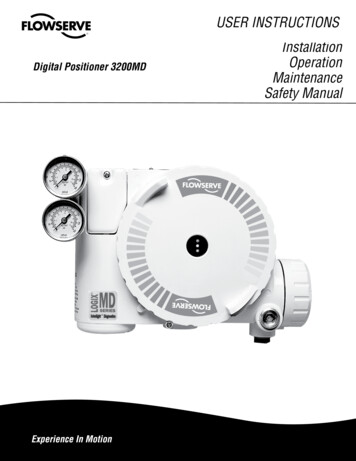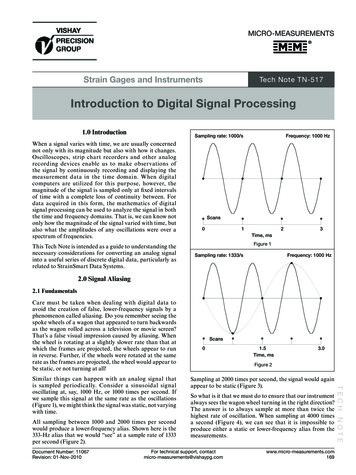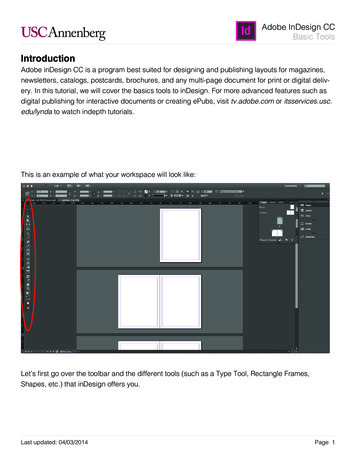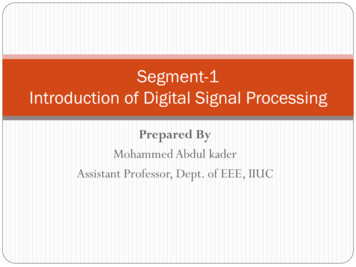
Transcription
Segment-1Introduction of Digital Signal ProcessingPrepared ByMohammed Abdul kaderAssistant Professor, Dept. of EEE, IIUC
Contents Signals, systems and signal processing. Basic Elements of DSP. Advantages and Disadvantages of DSP. Application of DSP. Types of Signal. A/D Conversion. ProblemsText Book:Digital Signal Processing (4th Edition), John G. Proakis, Dimitris K Manolakis2Lecture materials on "Introduction of Digital Signal Processing" By- Mohammed abdul kader, Assistant Professor, EEE, IIUC
Signals, Systems and Signal ProcessingSignalA signal is defined as any physical quantity that varies with time, space or any otherindependent variable or variables. Mathematically, we describe a signal as a function of one ormore independent variables. For example,𝑆1 (𝑡) 5𝑡𝑆 𝑥𝑦 3𝑥 2𝑥𝑦 5𝑦 2 Speech, electrocardiogram and electroencephalogram signals are examples of informationbearing signals that evolve as function of a single independent variable. Two dimensional signal An example of a signal that is a function of two independentvariable is an image signal. A video signal is function of three independent variables.3Lecture materials on "Introduction of Digital Signal Processing" By- Mohammed abdul kader, Assistant Professor, EEE, IIUC
Signals, Systems and Signal Processing (Cont.)SystemA system may be defined as a physical device that performs an operation on a signal. Forexample, a filter used to reduce the noise and interference corrupting a desired informationbearing signal is a system.Signal ProcessingWhen we pass a signal through a system, we say that we have processed the ssing4Lecture materials on "Introduction of Digital Signal Processing" By- Mohammed abdul kader, Assistant Professor, EEE, IIUC
Basic Elements of a DSP SystemA/D Converter: Digital Signal Processing provides an alternative method for processing theanalog signal. To perform the processing digitally, there is a need for an interface between the analogsignal and the digital processor. This interface is called analog-to-digital (A/D) converter.DSP: The digital signal processor may be a large programmable digital computer or a smallmicroprocessor programmed to perform the desired operation in the input signal.D/A Converter: The digital output from the digital signal processor is to be given to the user inanalog form. This is done by another interface called a digital-to-analog(D/A) converter.5Lecture materials on "Introduction of Digital Signal Processing" By- Mohammed abdul kader, Assistant Professor, EEE, IIUC
Advantages of Digital over Analog Signal Processing1) DSP Systems are reconfigurable: A digital programmable system allows flexibility inconfiguring the digital signal processing operations simply by changing the program.Reconfiguration of an analog system usually a redesign of hardware followed by testing andverification to see that it operates properly.2) Accuracy Consideration: Tolerances in analog circuit components make it extremedifficult for the system designer to control the accuracy of an analog signal processing system.On the other hand, a digital system provides much better control of accuracy requirements.3) Storing Data: Digital signals are easily stored on magnetic media (tape or disk) without deterioration or loss of signal fidelity beyond that introduce in the A/D conversion. As aconsequence, the signals become transportable and can be processed off-line in a remotelaboratory.6Lecture materials on "Introduction of Digital Signal processing" By- Mohammed abdul kader, Assistant Professor, EEE, IIUC
Advantages of Digital over Analog Signal Processing (Cont.)4) Signal Processing Algorithm: The digital signal processing method also allows for theimplementation of more sophisticated signal processing algorithms. It is usually very difficult toperform precise mathematical operations on a signal in analog form but these same operations canbe routinely implemented on a digital computer using software.5) Cost: In some cases a digital implementation of the signal processing system is cheaper than itsanalog counterpart.Disadvantages of Digital Signal ProcessingOne practical limitation is the speed of operation of A /D converters and digital signalprocessors. We shall see that signals having extremely wide band widths require fast-samplingrate A /D converters and fast digital signal processors. Hence there are analog signals with largebandwidths for which a digital processing approach is beyond the state of the art of digitalhardware.7Lecture materials on "Introduction of Digital Signal Processing" By- Mohammed abdul kader, Assistant Professor, EEE, IIUC
Classification of Signals: Multichannel and MultidimensionalMultichannel SignalIn some application, signals are generated by multiple source or multiple sensors. Such signals, inturn, can be represented in vector form. We refer to such a vector of signals as a multichannel signal.In electrocardiogram, for example, 3-lead and 12-electrocardiogram (ECG) are often used in practicewhich result in a 3 channel and 12 channel signals.Multidimensional SignalIf the signal is a function of a single independent variable, the signal is called a one dimensional signal.On the other hand, a signal is called M-dimensional if its value is a function of M independent variable.Black and white picture is an example of a two-dimensional signal, since the intensity or brightnessI(x,y) at each point is a function of two independent variables.Black and white TV picture me be treated as a three-dimensional signal.Color TV picture is a three-channel and three-dimensional signal.𝐼𝑟 (𝑥, 𝑦, 𝑡)𝐼 𝑥, 𝑦, 𝑡 𝐼𝑔 (𝑥, 𝑦, 𝑡)𝐼𝑏 (𝑥, 𝑦, 𝑡)8Lecture materials on "Introduction of Digital Signal Processing" By- Mohammed abdul kader, Assistant Professor, EEE, IIUC
Classification of Signals: Continuous Time and Discrete Time SignalContinuous Time SignalContinuous signals or analog signals are defined for every value of time and they take on values in thecontinuous interval (a,b), where a can be and b can be Examples: 𝑥1 𝑡 cos (𝜋𝑡)𝑥2 𝑡 𝑒 𝑡𝑤ℎ𝑒𝑟𝑒 𝑡 𝑡 Discrete time SignalDiscrete time signals are defined only at certain specific values of time. These time instants need not beequidistant, but in practice they are usually taken at equally spaced intervals.Examples:0.8𝑛 ,𝑛 0𝑥1 𝑛 0, 𝑜𝑡ℎ𝑒𝑟𝑤𝑖𝑠𝑒n is integer number.9Lecture materials on "Introduction of Digital Signal Processing" By- Mohammed abdul kader, Assistant Professor, EEE, IIUC
Classification of Signals: Continuous Valued and Discrete ValuedThe values of a continuous time or discrete time signal can be continuous or discrete.Continuous Valued Signal: If a signal takes on all possible values on a finite or an infinite range, it issaid to be a continuous valued signal.Discrete Valued Signal: Alternatively, if the signal takes on values from a finite set of possiblevalues, it is said to be discrete-valued signal.Digital Signal: A discrete time signal having a set of discrete values is called a digital signal. In orderfor a signal to be processed digitally, it must be discrete in time and its values must be discrete (i.e. itmust be digital signal)10Lecture materials on "Introduction of Digital Signal Processing" By- Mohammed abdul kader, Assistant Professor, EEE, IIUC
Classification of Signals: Deterministic and Random SignalDeterministic Signal: Any signal that can be uniquely described by an explicit mathematicalexpression, a table of data or a well defined rule is called deterministic. This term is used to emphasizethe fact that all past, present and future values of the signal are known precisely without anyuncertainty.Random Signal: In many practical application the signals can not be described to any reasonabledegree of accuracy by explicit mathematical formulas, or such description is too complicated to be anypractical use.The lack of such a relationship implies that such signals evolve in time is an unpredictable manners. Werefer to these signals as random.The o/p of noise generation, the speech signal are example of random signals.11Lecture materials on "Introduction of Digital Signal Processing" By- Mohammed abdul kader, Assistant Professor, EEE, IIUC
Typical Digital Signal Processing Example in Real-WorldApplicationsDigital Crossover Audio System An audio system is required to operate in an entire audible range of frequencies, which may bebeyond the capability of any speaker driver. Several drivers, such as the speaker cones and horns, each covering a different frequency range, areused to cover the full audio frequency range. Figure shows a two-band digital crossover system consisting of two speaker drivers: a woofer and atweeter. The woofer responds to low frequencies, while the tweeter responds to high frequencies. The incoming digital audiosignal is split into two bandsby using a digital low passfilter and a digital high passfilter in parallel. Then the separated audio signals are amplified and finally sent to their corresponding speaker driver.12Lecture materials on "Introduction of Digital Signal Processing" By- Mohammed abdul kader, Assistant Professor, EEE, IIUC
Typical DSP Example in Real-World Applications (Continued)Interference Cancellation in Electrocardiography In ECG recording, there often is unwanted 60-Hz interference in the recorded data. The interference comes from the power line and includes magnetic induction, displacement currentin the leads or in the body of the patient, effects from the equipment interconnections, and otherimperfections. Although using proper grounding ortwisted pairs minimizes such 60 Hzeffects, another effective choice canbe use of a digital notch filter, whicheliminates the 60 Hz interferencewhile keeping all other usefulinformation13Lecture materials on "Introduction of Digital Signal Processing" By- Mohammed abdul kader, Assistant Professor, EEE, IIUC
Typical DSP Example in Real-World Applications (Continued)Speech Coding and Compression Analog signal is first sent through an analog low pass filter to remove high frequency noisecomponents and is then passed through the ADC unit, where the digital values at sampling instantsare captured by the DS processor. Next, the captured data are compressed using data compression rules to reduce the storagerequirements. Finally, the compressed digital information is sent to storage media. To retrieve the information, the reverse process is applied. The DS processor decompresses the datafrom the storage media and sends the recovered digital data to DAC. The analog output is acquired byfiltering the DAC output via the reconstruction filter.Simplified dataCompressorSimplified datadecompressor14Lecture materials on "Introduction of Digital Signal Processing" By- Mohammed abdul kader, Assistant Professor, EEE, IIUC
Application of DSP15Lecture materials on "Introduction of Digital Signal Processing" By- Mohammed abdul kader, Assistant Professor, EEE, IIUC
Analog to digital ConversionSampling : This is the conversion o f a continuous-time signal into a discrete time signal obtained bytaking “ samples’" of the continuous-time signal at discrete-time instants. Thus, if 𝑥𝑎 (𝑡) is the inputto the sampler, the output is 𝑥𝑎 𝑛𝑇 𝑥 𝑛 , where T is called the sampling interval.Quantization : This is the conversion o f a discrete-time continuous-valued signal 𝑥(𝑛)in to adiscrete-time, discrete-valued (digital) signal 𝑥𝑞 (𝑛). The value of each signal sample is representedby a value selected from a finite set o f possible values.Coding: In the coding process, each discrete value 𝑥𝑞 (𝑛) is represented by a b-bit binary sequence.16Lecture materials on "Introduction of Digital Signal Processing" By- Mohammed abdul kader, Assistant Professor, EEE, IIUC
Sampling of Analog SignalsPeriodic or uniform sampling is described by the relation-𝑥 𝑛 𝑥𝑎 𝑛𝑇 , 𝑛 where x(n) is the discrete-time signal obtained by “ taking samples” of the analog signal 𝑥𝑎 (𝑡) atevery T seconds. The time interval T between successive samples is called the sampling period orsample interval and its reciprocal1𝑇 𝐹𝑠 is called the sampling rate (samples per second) or thesampling frequency (hertz).17Lecture materials on "Introduction of Digital Signal Processing" By- Mohammed abdul kader, Assistant Professor, EEE, IIUC
Sampling of Analog Signals (Cont.)Periodic sampling establishes a relationship between the time variables t and n of continuous-time anddiscrete-time signals.𝑛𝑡 𝑛𝑇 𝐹𝑠If the analog signalSampled periodically at a rate 𝐹𝑠 1 𝑇, the digital signal can be expressed asFrom above relationship between the frequency variable F (or Ω) for analog signals and the frequencyvariable f (or 𝜔) for discrete-time signals.The frequency variable f of discrete signal is sometimes called Relative normalized frequency18Lecture materials on "Introduction of Digital Signal Processing" By- Mohammed abdul kader, Assistant Professor, EEE, IIUC
Alias of FrequencyConsider two sinusoidal analog Signals:If they are sampled at a rate 𝐹𝑠 40 𝐻𝑧, The corresponding discrete time signal will be:Thus the sinusoidal signals are identical and consequently, indistinguishable.Since 𝑥2 (𝑡) yields exactly the same values as 𝑥1 (𝑡) when the two are sampled at 𝐹𝑠 40samples per second, we say that the frequency 𝐹2 50 𝐻𝑧 is an alias of the frequency𝐹1 10 𝐻𝑧 at the sampling rate of 40 samples per second.It is important to note that 𝐹2 is not only the alias of 𝐹1 . In fact at the sampling rate of 40 samplesper second, the frequency 𝐹3 90 𝐻𝑧, 𝐹4 130 Hz . So on are also an alias of 𝐹1 .In general, all of the sinusoids cos 2𝜋 𝐹1 40𝐾 𝑡 , 𝑘 1,2,3 . , sampled at 40 samples persecond are the aliases of 𝐹1 10 𝐻𝑧.19Lecture materials on "Introduction of Digital Signal Processing" By- Mohammed abdul kader, Assistant Professor, EEE, IIUC
Alias of Frequency (What should be the sampling Rate?)20Le
Lecture materials on "Introduction of Digital Signal Processing" By- Mohammed abdul kader, Assistant Professor, EEE, IIUC 2 Text Book: Digital Signal Processing (4th Edition), John G. Proakis, Dimitris K Manolakis Signals, systems and signal processing. Basic Elements of DSP. Advantages and Disadvantages of DSP. Application of DSP.
